I am very lucky where I live that I get to ride in some pretty picturesque areas. Here are just a few photos from the passed few weeks.
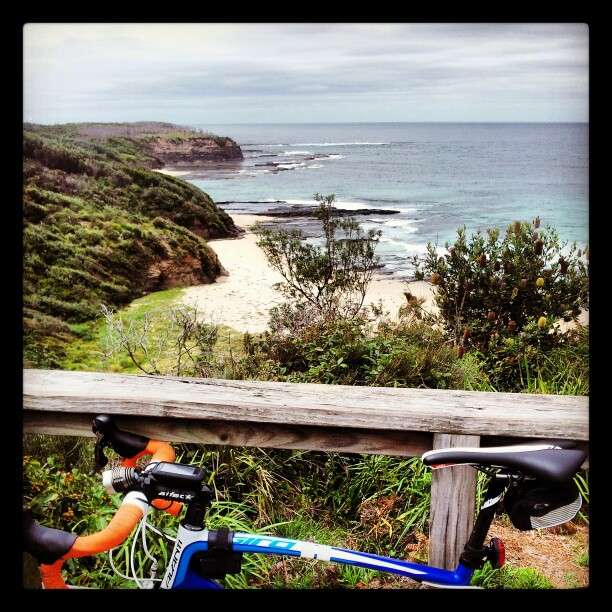


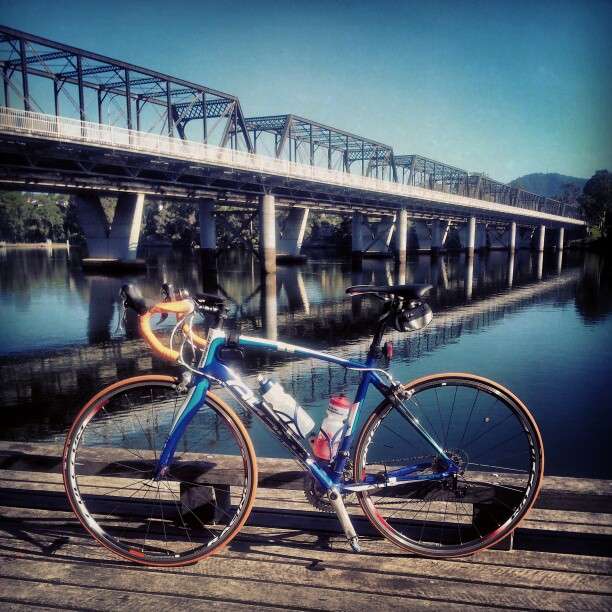
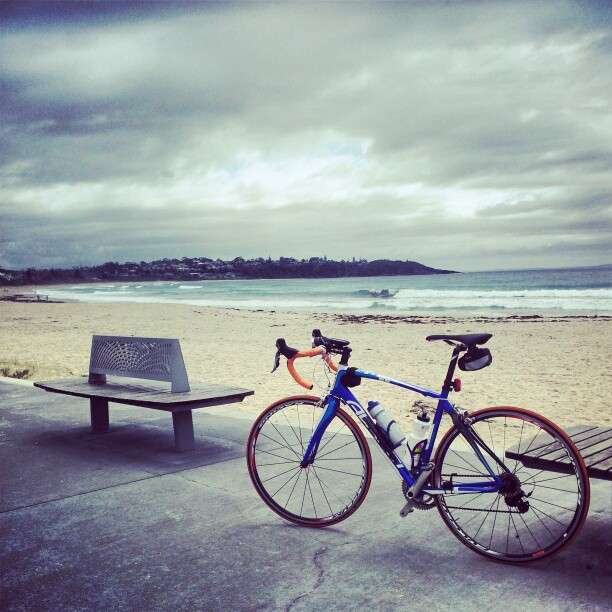

I am very lucky where I live that I get to ride in some pretty picturesque areas. Here are just a few photos from the passed few weeks.





Talk about showing off! 🙂
I saw this terrific article retweeted today and though I would share it.
I didn’t need the numbers to know I am so, so far behind the elite guys it is ridiculous.
Have a read and leave a comment.
![]()
This article was originally published at The Conversation.
Read the original article.
By Ken Taylor, CSIRO
If you’ve ever watched a professional bike race such as the Tour de France on TV, you might have thought to yourself: “Just how good are the professionals?” And if you do a bit of cycling yourself, you might be inclined to wonder: “How much better are they than me?”
Using data from the 2013 Tour Down Under – held in late January in and around Adelaide – I was able to compare the efforts of amateur recreational cyclists against those of professionals in the race.
On Stage 4 of the Tour Down Under more than 6,500 recreational cyclists took part in the Bupa Challenge Tour, riding along the same route as the professionals just a few hours before the race.
Of the 6,500 cyclists that took part in the recreational event, 950 recorded their ride using the popular “social fitness” website Strava. I was then able to analyse this wealth of shared data to compare the efforts of amateur cyclists with the efforts of professional rider Serge Pauwels from the Omega Pharma-Quickstep team.

While German sprinter Andre Greipel won that Tour Down Under stage at the head of the peloton, Pauwels finished 42nd as part of the same group. This meant that Pauwels’s time was considered equal to that of Greipel’s.
As Pauwels remained in the peloton all day, riding conservatively, his effort represents the minimum needed to ride with the pros on a fast stage that averaged 41.5km/h.
So how did the non-pro riders perform over the same course?
While there could be a difference in the effort put in by pros and amateurs – for a start, the pros were racing and the public were not – many riders seem to have been giving it their best, particularly the faster amateurs.
As Kalvin Bartlett, the 10th fastest amateur rider on the day (from those on Strava) said: “… some people need to distinguish between a charity ride and a race”.
The amateur riders also had to be motivated enough to turn up and choose the full 127km of Stage 4 rather than one of the shorter alternatives available on the day. This would suggest that the riders in question are all reasonably strong.
(If you didn’t ride in the Bupa Challenge you can get a rough idea of how you would have gone by comparing your average speed over a long ride to that of the amateur field below. You’d have to be able to average a punishing 26km/h including rest stops to make the top half of the amateur field in the Bupa Challenge Tour.)

The image above shows that Pauwels and the rest of the riders in the pro peloton were 4.4 standard deviations faster than the mean of everyone else and a full 5.7km/h faster than the quickest amateur.
How did they do it?
Well the obvious answer would be “they pedalled harder” but as it turns out, for the best of the amateurs, this isn’t the case.
A cyclist generates power to propel the bike forward, and this is measured by multiplying the force they exert on the pedals by how fast the pedals are rotating. Power is lost to air drag, rolling resistance and fighting gravity as they climb hills.
The heavier the cyclist, the higher the power they should be able to produce. As such, Serge Pauwels’s weight of 64kg makes his average of 223W more impressive than if he’d been, say, 80kg.
A cyclist can produce high power for short intervals but this will leave them tired. Each cyclist has a maximum amount of power they can produce over any particular interval. These best efforts can be shown in a curve compiled from their highest power over multiple efforts.
The image below compares Pauwels’s previously established best-effort power curve (dashed blue line) against his power curve for stage 4 (dashed red line) and the power curves of the four fastest amateurs (as per Strava) that had power meters during the Bupa Challenge Tour.

This image shows that Pauwels rode at his long-distance best but fairly conservatively – that is, he was well below his best over shorter intervals.
This conservative riding would have helped Pauwels stay fresh enough to achieve strong results in later stages of the six-stage tour. In turn, these strong results allowed him to finish the Tour Down Under in 20th place overall.
Three of the amateurs produced a higher average power than Pauwels, including one who recorded 243W – nearly 10% more than Pauwels’s 223W.
And one of the amateurs, “Spartacus Flying Scotsman”, was able to ride more conservatively (i.e producing less power in short intervals – see figure 3 above) while producing more power overall.
But Pauwels was more efficient, riding at a higher average speed from a lower average power than all of the amateurs.
Just how efficiently Pauwels rode can be seen by plotting speed against power, for all riders who uploaded power meter data to Strava (as seen in figure 4 below). Only 28 of the 950 riders used power meters and of these four were identified as unreliable and excluded.

The power required to overcome air drag is proportional to a rider’s velocity cubed (i.e. the drag increases dramatically the faster you go). And yet the power vs speed relationship for the amateurs is approximately linear.
This is unexpected, but because Pauwels is well below the trend, it emphasises just how efficiently he rode.
So, to keep up with the pros, the average Bupa Challenge rider needs to produce an additional 50W – an increase of a little more than a third – and ride much more efficiently to increase their speed by more than 50%.
And for the rest of us, matching the pros is an even more difficult task – most probably couldn’t ride 127km at any speed.
Ken Taylor has previously conducted cycling research funded through a CSIRO and AIS partnership. See http://www.csiro.au/en/Organisation-Structure/Divisions/Materials-Science–Engineering/CSIRO-and-AIS.aspx .
He works for CSIRO.
![]()
This article was originally published at The Conversation.
Read the original article.
Today I had to do a trip down south to Ulladulla to drop some cushions off for the brides business. (www.cooshonz.com) Whilst there, I thought I would take the opportunity to ride somewhere I hadn’t ridden before. I remember it being lumpy, but good lord.
On the way home, I was chatting to my mate Josh from Brisbane. He asked about the ride and with out much thought I described it as being lumpier than Christina Hendricks chest. He dared me to put that on the blog. I said I would go one better!

Copyright of owner who is unknown.
There, so now that that is out of the way. To the ride.
It was a gray old day and it seemed very humid. I started out at the breakwater in the bay at Ulladulla.
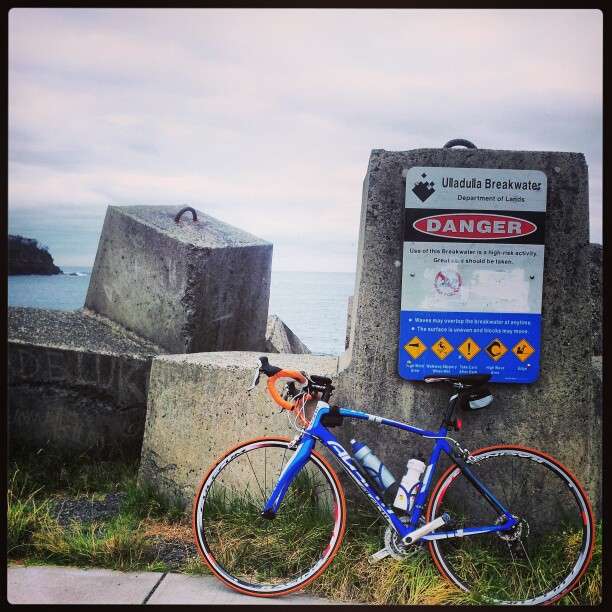
Breaking Water
From there it was up a hill that had be puffing before I had 500m on the Garmin. Said Garmin was also reporting 14% gradient at one point.
Here is the ride profile.
A the top of the hill I swung around and headed North, destination, Mollymook.
The run down the main street of Ulladulla was broken up by cars parking and lights. So much for getting a run up at the next climb. I slogged my way up to the Mollymook turn off then enjoyed a pretty swift run to Mollymook beach.

Mollymook Beach
I was sweating a fair bit and had a quick chat to an old bloke who used to be a cyclist. He was bewildered by my orange tyres.
I then headed further North to explore around Bannister Head. It is a very nice area with some great spots looking over the sea. I wasn’t stopping though, I needed to get out to Milton and then head back.
Just before you get back on to the highway at Milton there is a 500m climb that tops out at 17%. Well, that is what my Garmin said. It felt like 37%.
It was an enjoyable, if not lumpy, run along the highway back to Ulladulla. I decided to have a quick look around and went exploring. Here are a few of the spots I found.
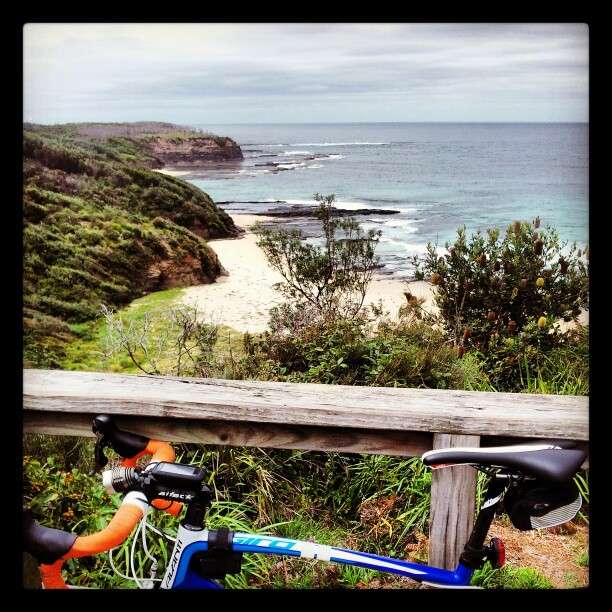
Ocean Views

Same Same

Where the light lives.
I then headed back to the car. It was a terrific ride and I will be heading back to do it again. Highly recommended if you are in the area.
Check out my ultra smooth and super slow cadence. Also, watch me accelerate when I do pedal.

😀
Thanks Dave for the source video. Animated GIFs are fun.
Any comments about the stunning Non Pro Cycling jersey and I will hunt you down. 😉
Ellis Cycles from Chris Harris on Vimeo.
Dave Wages builds a frame from Reynolds 953, True Temper S3 and Dedacciai tubing to be displayed unpainted at the 2011 North American Hand Made Bicycle Show in Austin, Texas, February 25-27.
How good does it look to be in the crowds?
2013 UCI World Cyclocross Championships from Gizmo Pictures on Vimeo.
How much can one person see during a day of cyclocross racing? Look through the lens of Keith Walberg as he made his way around Eva Bandman Park in Louisville, Kentucky. The atmosphere was electric for the first ever elite world cyclocross championships held in North America.
soundtrack: Experience by Ludovico Einaudi
camera: Panasonic GH2
Kudos Keith Walberg for the video and thank you to Lesli Cohen for the heads up.
This blog post has been a long time in writing. I first started writing a ranty little burst of words after a Twitter dispute with Australian sports journalist Debbie Spillane. She was commenting on a tennis match in the US Open. Here is what started it.
@debspillane and they say cyclist are the only dopers!
— norbs (@norbs) September 11, 2012
@norbs not with you there. Think you’re sounding like a bitter cycling fan.
— DebbieSpillane (@DebSpillane) September 11, 2012
@debspillane I didn’t expect you to agree. It isn’t normal though.
— norbs (@norbs) September 11, 2012
I then replied to her with this link…
http://tennishasasteroidproblem.blogspot.com.au/
To her credit, she retweeted it to her followers.
After a few minutes with my mouse hovering over the “Publish” button in WordPress, I thought better of it and saved it as a draft. As I said, it was a ranty, nasty little bunch of sentences that would have served no purpose other than making me feel a little better for a few minutes until I cooled off. It was one time when the mature, considered side of my brain won out over the testosterone fueled, arsehole side of my brain. A minor miracle.
Since then, we cycling fans have been subjected to the USADA reasoned decision and, as a consequence, the fall of the Yellow Curtain. Cycling has taken a kicking. Time and time again I have been in discussion with fans of other sports trying to justify my love of this so called joke of a sport. It has been hard work. Often I have wanted to fire off Tweets or emails laced with my own unique brand of diplomacy. Diplomacy laced with F bombs and other school yard taunts. For once, I have resisted the urge.
Now though, it is time for a few pointers to those that keeping pointing to cycling as morally corrupt sport in the greater sporting world. Over the past few weeks, there have been a handful of stories emerge that make it look like cycling isn’t the black sheep of the sporting family. Cycling it seems has quite a few siblings.
Let us wade through the ever deepening pool of dirty sports.
May as well start with tennis. The best place to look is the link above. There is a hell of a lot of information on that site, but the juicy stuff is in the Recommended Reading section.
Really, it seems very straight forward to me. When you have the top mens players serving at 200kph for hours on end, with no apparent drop in speed, something isn’t normal. Seeing guys getting around the court like their backside is on fire after a 5 hour game. Or play an epic, and then are back out there again the next day, as fresh as a daisy. Again, you have to ask questions.
Here is a nice little set of numbers. “Blood tests accounted for between three and six percent of all tests in tennis in 2011, compared to 35 percent in cycling and 17.6 percent in athletics.” This article is also worth a read. http://uk.reuters.com/
Ok, so lets take a look at football, or soccer, depending on where you live. Performance Enhancing Drugs aside, this little story popped up the other day. An estimated 680 games have been fixed, it has been alleged.
“The European Union’s police agency said an 18-month review found 380 suspicious matches in Europe and another 300 questionable games outside the continent, mainly in Africa, Asia and South and Central America. It also found evidence that a Singapore-based crime syndicate was involved in some of the match-fixing.” More about that here.
So, match fixing. And if it isn’t enough that you have guys diving like they have been hit in the shin by a weapon of mass destruction. They are also doping!
There is an excellent article at inring.com that talks about doping in football. Check it out here.
Not a good look for the world game. Given the fact that Eufemiano Fuentes, the controversial doctor at the heart of the “Operación Puerto”, has been tied to footballers as well as cyclist and tennis players, you’d have to be deluded to think football is a clean sport.
Closer to home, just popping up today is the story of an AFL that may end up in hot water. The article, in the very early stages of it breaking, can be found here. Supplements hey? This will be an interesting one to watch.
Even the worlds fastest man isn’t fast enough to escape questioning. When Carl Lewis is asking questions, you have to wonder. I have no idea when it comes to athletics, but the numbers quoted do make you scratch your chin. (Thanks to JournalVelo for the link)
I had quite a few links to look at in regards American sports. Baseball, basketball and NFL. Then I was alerted to an article by Bill Simmons that did a better job than I ever could of taking apart American sports and PED usage. This truly is a remarkable piece of writing. Check it out at www.grantland.com.
Here is just a small extract, but it shows just how ridiculous testing in basketball is…
“NBA players get tested up to four times during the course of a season. The fourth time can happen at any point from October to June, but once it happens, that’s it. So if your fourth test occurs after your 71st game, you’re clear the rest of the way. It’s a running joke within NBA circles, something of a get-out-of-jail-free card: Once you pee in that fourth cup, you’re good to go. Put whatever you want into your body. Feel like smoking enough weed to make Harold and Kumar blush? Knock yourself out. Feel like replacing your blood with cleaner blood so you have more endurance for the playoffs? Knock yourself out. Feel like starting a testosterone cycle because you might have to play 25 grueling playoff games over the next 10 weeks? Knock yourself out. Remember how competitive these guys are. What would they do for an edge? How far would they go? And why are we giving them the choice?” – Bill Simmons.
Having been convinced to watch a NFL game a few weeks back, I was stunned to hear stats about guys way heavier than myself, doing sub 11 second 100m times. I asked a few NFL fans at the time about the drug testing business. It was mentioned if a player tested positive they received a 4 week ban and no pay! Surely, this had to be wrong.
I dug this up.
PENALTIES — NFL
First: A four game suspension without pay.
Second incident: Eight game suspension, no salary.
Third: One year suspension, no pay.
Sweet quarter back in a dress! It is all spelled out on this page. www.csnbayarea.com/blog/biz-ball/sports-drug-testing-policies-nfl-nba-nhl-olympics.
So dear cycling fan, I hope that next time a fan of another sport tells you cycling is a sport full of cheats, you may be able to point them to a link in this post, or this actual post and let them know that cheating by doping isn’t just limited to cycling. It seems to be everywhere. If you want to trawl through a pretty comprehensive list of sports dopers, not just PED users, but all banned drugs, check out this Wiki entry. (Thanks Toby Forage for the link)
If you have links to stories that you think are relevant, please put them in the comments below.
I will let Jim Courier have the final word.
“Let’s face it, if you’re 100 in the world and you think that something illegal will get you to 10 in the world, that’s a tremendous difference in the quality of the rest of your life from a financial standpoint.”
Juniors Mens
Womens
Mens
© 2009-2025 Non Pro Cycling All Rights Reserved -- Copyright notice by Blog Copyright